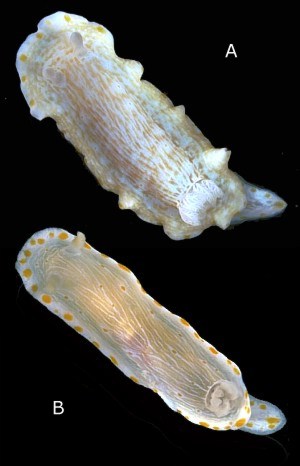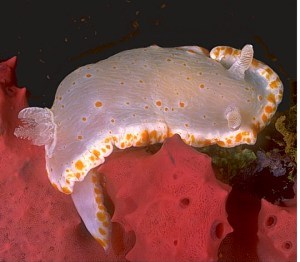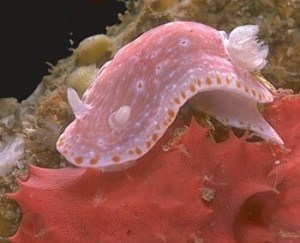
Chromodoris epicuria
(Basedow & Hedley, 1905)
Order: NUDIBRANCHIA
Suborder: DORIDINA
Superfamily: EUDORIDOIDEA
Family: Chromodorididae
PHOTO
UPPER RIGHT: A, Mallacoota, northern Victoria, 14mm long alive, February 1983. B, Bicheno, eastern Tasmania, 31mm long alive, May 1985. LOWER LEFT: Ulverstone, northern Tasmania, 35mm long alive, February 1984. On food sponge Darwinella gardneri. LOWER RIGHT: Eyre Peninsula, South Australia, 23mm long alive, February 1985. On food sponge Darwinella cf. gardneri. PHOTOS: Bill Rudman.
There is some variation in colour in this species throughout its range, different parts of the colour pattern being emphasised in different populations. In general the body and mantle are translucent whitish with the creamy-brown or pinkish viscera showing through. Around the edge of the mantle is a broad band of opaque white resulting from both surface pigmentation and the opaque white subepithelial mantle glands. The mantle is marked with thin irregular white lines arranged longitudinally. There are also large orange spots which form a submarginal band around the mantle and smaller orange spots scattered all over the central part of the mantle. Each of these small orange spots sits on a white line and is surrounded by a thin white ring. The orange ranges from a pale yellow-orange to a dark red-orange in different specimens. The gills and rhinophores are translucent and both are edged in white. The foot and the sides of the body are translucent with a dusting of white. There is a submarginal band of orange spots around the foot, including the anterior edge.
Regional variation:
•Victoria: Specimens from Mallacoota in northeastern Victoria are heavily pigmented with creamy-white closely spaced lines forming a prominent pattern on the dorsum. The background colour is a translucent yellow-brown. Orange spots form a submarginal band around the mantle edge but there are few orange spots elsewhere on the mantle. In contrast specimens from Western Port and Port Phillip Bay in southern Victoria have a translucent mantle finely dusted with white and with traces of longitudinal white lines. There are orange spots scattered over the central part of the mantle. •Tasmania: Specimens from both the northern and southern coasts are similar to the southern Victorian specimens.
• South Australia: Specimens from both the Eyre and Yorke Peninsulas were examined. In both samples the longitudinal white lines though often present were not prominent. The orange spots in the central part of the mantle are each surrounded by a prominent white ring and the spot is usually slightly raised. The background of the mantle has either very little white dusting and so is translucent except for the opaque viscera and white band of mantle glands, or was heavily dusted in red giving the body a deep pinkish background. Most specimens with a deep pinkish background have only irregular traces of the longitudinal white lines. One consequence of the pinkish background is that the orange spots on the inner part of the mantle appear much darker (almost red) than those forming the submarginal mantle band where the background is white. In these pinker specimens there is often orange spots or lines on the edge of the gills.
This species was described from South Australia eighty years ago (Basedow & Hedley, 1905) but as the original description was based on one specimen of an unusual colour form it has remained unrecognised in the literature since that time. Burn (1957), named the common Victorian colour form, with distinctive longitudinally arranged white lines, Glossodoris victoriae, not recognising its relationship to Basedow & Hedley's Hypselodoris epicuria. Specimens from Tasmania are very similar in colour to those from southern Victoria and some specimens from both the Eyre and Yorke Peninsulas of South Australia have the typical colour pattern of "Glossodoris victoriae". Many of the specimens from Eyre Peninsula however show partial or complete loss of the longitudinal white lines and sometimes the development of red dusting over the dorsum, giving the body a reddish pink appearance. Specimens with a heavy red dusting and complete loss of the white lines fit the original illustration of Hypselodoris epicuria very well. See page on red-spotted species from south eastern Australia. Compare with C. tasmaniensis and C. splendida.
References:
•Rudman, W.B. (1983 ) The Chromodorididae (Opisthobranchia: Mollusca) of the Indo-West Pacific: Chromodoris splendida, C. aspersa and Hypselodoris placida colour groups. Zoological Journal of the Linnean Society, 78: 105-173.
•Rudman, W.B. (1987a) The Chromodorididae (Opisthobranchia: Mollusca) of the Indo-West Pacific: Chromodoris epicuria, C. aureopurpurea, C. annulata, C. coi and Risbecia tryoni colour groups. Zoological Journal of the Linnean Society, 90: 305-407.
•Rudman, W.B. (1991) Purpose in Pattern: the evolution of colour in chromodorid nudibranchs. Journal of Molluscan Studies, 57, (T.E. Thompson Memorial Issue): 5-21.
PHOTOS:
UPPER RIGHT: A, Mallacoota, northern Victoria, 14mm long alive, February 1983. B, Bicheno, eastern Tasmania, 31mm long alive, May 1985. LOWER LEFT: Ulverstone, northern Tasmania, 35mm long alive, February 1984. On food sponge Darwinella gardneri. LOWER RIGHT: Eyre Peninsula, South Australia, 23mm long alive, February 1985. On food sponge Darwinella cf. gardneri. PHOTOS: Bill Rudman.


Rudman, W.B., 1999 (October 11) Chromodoris epicuria (Basedow & Hedley, 1905). [In] Sea Slug Forum. Australian Museum, Sydney. Available from http://www.seaslugforum.net/factsheet/chroepic
Related messages
-
Re: Chromodoris multimaculosa from Bicheno, Tasmania
From: Capt John Silberberg, May 31, 2010 -
Re: Chromodoris multimaculosa from Bicheno, Tasmania
From: Greg Close, May 31, 2010 -
Chromodoris multimaculosa from Bicheno, Tasmania
From: Capt John Silberberg, May 29, 2010 -
Can you please id this nudi?
From: Trevor McMurrich, October 26, 2006 -
Chromodorid from S.E. Australia
From: John Chuk, June 26, 2002 -
Chromodoris epicuria from South Australia
From: Stuart Hutchison, March 8, 2002 -
Chromodorid from South Australia
From: John Chuk, August 21, 2001
